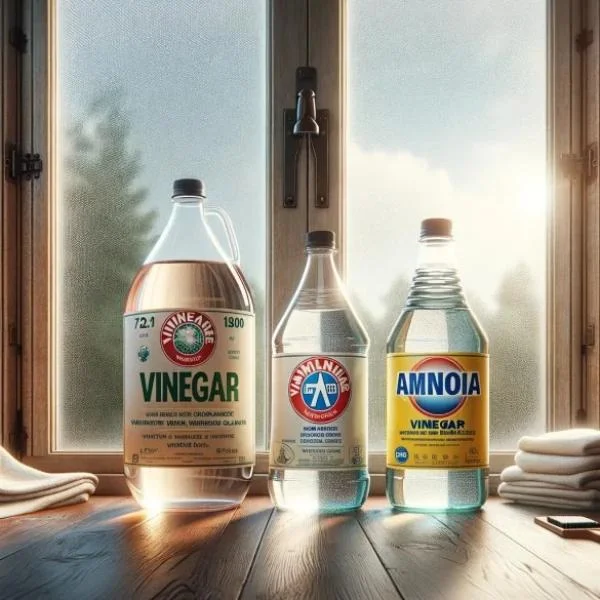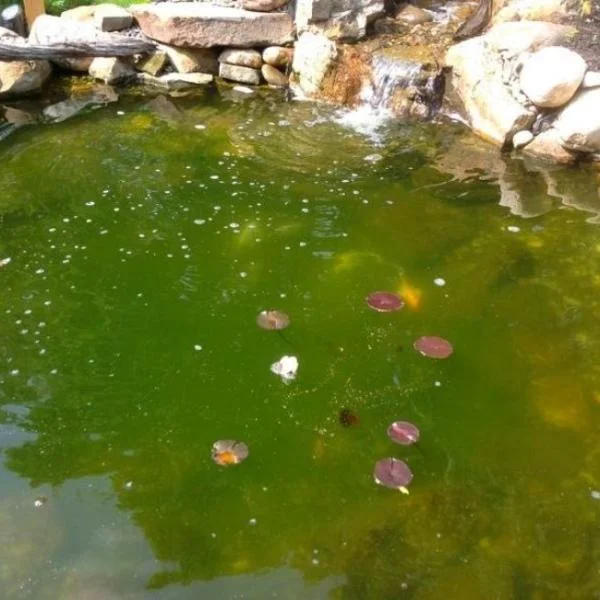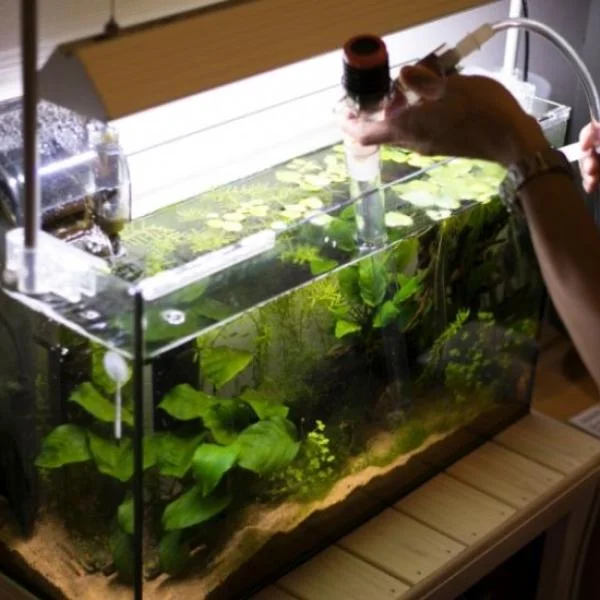
Pond water quality is crucial for maintaining a healthy aquatic ecosystem that supports fish, plants, and beneficial bacteria. This comprehensive guide explores essential water quality parameters, testing methods, and management strategies to help pond owners maintain optimal conditions for their water features.
Why Pond Water Quality Matters
The health of your pond ecosystem directly depends on maintaining proper water quality parameters. Poor water quality can lead to fish kills, excessive algal blooms, unpleasant odors, and overall ecosystem deterioration. Understanding and monitoring these parameters is essential for successful pond management.
Essential Pond Water Quality Parameters
Dissolved Oxygen (DO)
Dissolved oxygen is perhaps the most critical parameter for pond health, as it is vital for the survival of fish and other aquatic organisms. Oxygen levels in water fluctuate based on temperature, biological activity, and aeration. Ideal oxygen levels range from 6.0 mg/L to the maximum dissolved oxygen capacity of 18.0 mg/L. However, levels below 6.0 mg/L can be harmful to fish and other pond life.
- Temperature Dependency: Cold water can hold more oxygen than warm water. In summer, warmer temperatures reduce the water’s oxygen-carrying capacity, often making it necessary to enhance aeration.
- Oxygen Sources: Oxygen enters the water through photosynthesis by aquatic plants and algae, and through atmospheric exchange at the water’s surface. To ensure adequate oxygen, ponds may benefit from artificial aeration methods, especially in warmer months.
Maintaining dissolved oxygen levels is especially important in ponds with high fish density, as fish require higher oxygen levels for respiration.
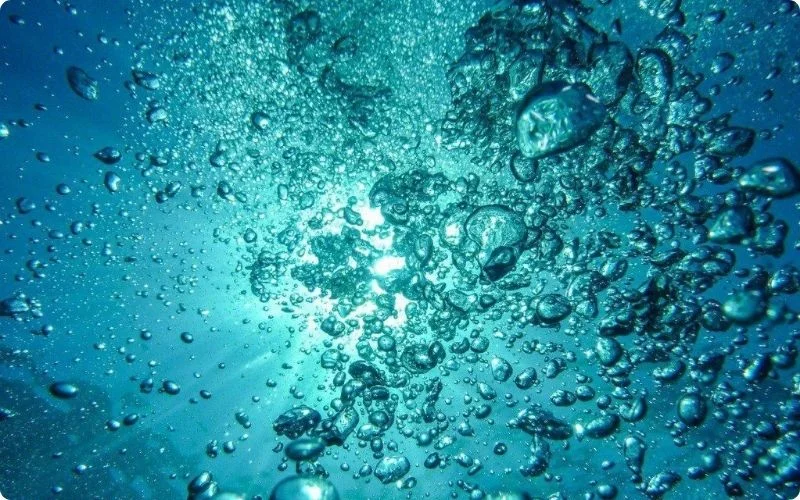
Dissolved oxygen is vital for the survival of fish and other aquatic organisms
pH Levels
pH measures the acidity or alkalinity of the water, and maintaining a stable pH range is essential for fish and other aquatic organisms. For ponds, the optimal pH range is between 7.5 and 8.5, which suits most pond species and promotes the growth of beneficial bacteria.
- Tolerance Range: While fish can generally tolerate pH levels between 6.8 and 8.6, abrupt changes or levels outside this range can cause stress or even harm.
- Diurnal Fluctuations: pH levels in ponds can fluctuate throughout the day, especially due to algae. During daylight, algae absorb carbon dioxide for photosynthesis, which can raise the pH. Therefore, it is recommended to test pH twice daily—morning and evening—to get an accurate range.
Temperature
Temperature plays a substantial role in determining the physical and chemical properties of water:
- Species-Specific Needs: Cold-water fish, like trout, prefer temperatures below 70°F, while warm-water fish, like koi or bass, thrive around the 80s°F. Knowing the preferred temperature range of your pond’s fish species is key to maintaining their health.
- Impact on Metabolism: Higher temperatures speed up metabolic processes in fish, plants, and bacteria, often leading to faster nutrient consumption and waste production. This can lead to spikes in ammonia and other pollutants.
- Temperature and Herbicides: Aquatic herbicides, used for controlling invasive plants, are most effective between 60-75°F. Applying herbicides outside this range can reduce their efficacy and increase the risk of harming fish.
In temperate regions, temperature fluctuations across seasons are normal, and seasonal adjustments (such as installing aeration in summer) may be necessary..
Alkalinity and Hardness
Alkalinity, or carbonate hardness (KH), is a measure of the water’s buffering capacity, which helps stabilize pH by neutralizing acids. General hardness (GH) indicates the presence of dissolved minerals, mainly calcium and magnesium, which are important for fish health.
- Optimal Alkalinity: For ponds, an alkalinity of around 100 ppm is recommended, with a range of 50-200 ppm considered acceptable. Adequate alkalinity helps prevent rapid pH shifts that could stress or harm fish and other aquatic life.
- Hardness Levels: Pond water hardness should generally be above 50 ppm. Hardness plays a role in fish osmoregulation, helping them balance water and mineral levels within their bodies, which is essential for overall health and resistance to disease.
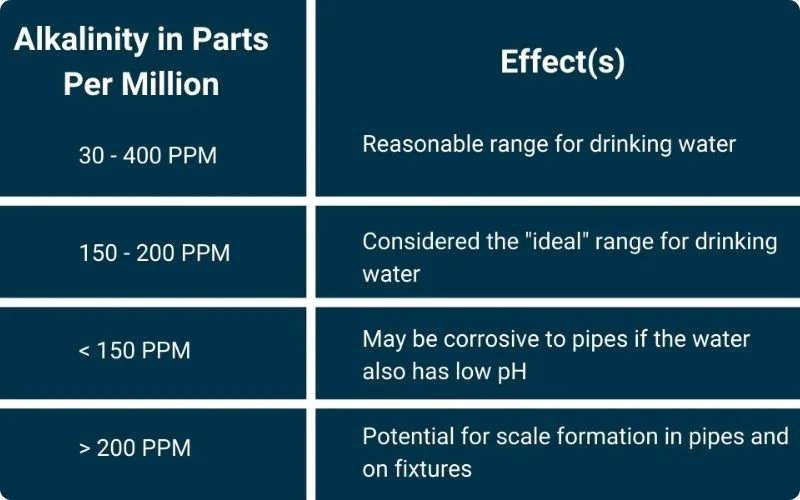
Alkalinity helps stabilize pH by neutralizing acids
Critical Nutrient Levels
Ammonia
Ammonia exists in two forms: un-ionized ammonia (NH3), which is highly toxic to fish, and ionized ammonia (NH4+), which is less harmful. It is essential to maintain ammonia levels below 0.5 ppm, with 0 ppm being ideal. Higher pH levels increase ammonia toxicity, so regular monitoring is necessary to ensure safety
Nitrates and Nitrites
- Nitrite levels should be kept below 0.5 ppm, as higher levels indicate potential toxicity.
- Nitrate levels should not exceed 25 ppm. Elevated nitrate levels are often a warning sign of water quality issues, indicating the need for better nutrient management.
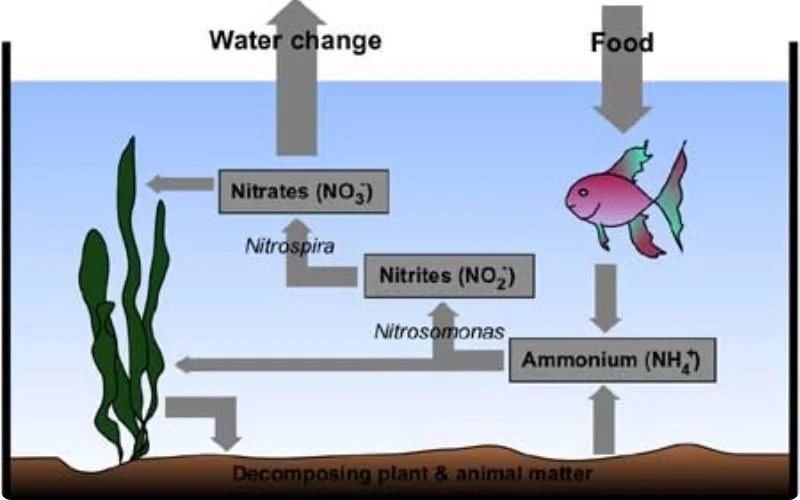
Nitrates and Nitrites
Phosphates
Phosphates should be maintained at approximately 0.05 ppm to limit excessive algae growth, which can disrupt the ecosystem. Common phosphate sources include soil, tap water, and fish food, making it essential to monitor these inputs carefully.
Suggested Pond Water Quality Standards
Parameter | Ideal Range | Critical Minimum | Maximum Safe Level |
Dissolved Oxygen | 6.0-18.0 mg/L | 6.0 mg/L | N/A |
pH | 7.5-8.5 | 6.8 | 8.6 |
KH (Carbonate Hardness) | 95-150 ppm | 95 ppm | 150 ppm |
GH (General Hardness) | 3-15 DH | 3 DH | 15 DH |
Ammonia | 0-0.5 ppm | 0 ppm | 0.5 ppm |
Nitrite | <0.5 ppm | 0 ppm | 0.5 ppm |
Nitrate | <25 ppm | 0 ppm | 25 ppm |
Phosphate | ~0.05 ppm | 0 ppm | 0.1 ppm |
Ways to Enhance Pond Water Quality
Aeration Techniques
Aeration is crucial for maintaining oxygen levels in ponds. Consider the following methods:
- Install waterfalls or fountains to increase water movement.
- Incorporate oxygenating plants that release oxygen into the water.
- Use air stones for direct oxygen injection, especially during warmer months when oxygen levels may decline.

Install waterfalls or fountains to increase water movement
Nutrient Management
Proper nutrient management prevents water quality issues associated with nutrient buildup. Effective strategies include:
- Establishing vegetated buffer strips around the pond to filter runoff.
- Minimizing runoff from fertilized areas near the pond.
- Regularly removing dead plant material that can decompose and release nutrients into the water.
- Controlling fish populations to avoid excessive waste accumulation.
Regular Maintenance
Routine maintenance is essential to keep water quality in check:
- Monitor water quality parameters frequently using test kits or professional services.
- Remove organic debris like fallen leaves to prevent decay in the pond.
- Maintain an efficient filtration system to reduce contaminants.
- Manage aquatic plant growth to avoid excessive competition for resources.
Evaluation and Tracking of Pond Water Quality
Regular testing is essential for maintaining optimal pond conditions. Various testing methods are available:
Professional Testing
Commercial laboratories offer comprehensive water quality analyses, providing accurate results across a wide range of parameters with detailed insights to guide pond management decisions.
DIY Testing Kits
Readily available DIY test kits from pet stores or online retailers allow quick assessments of basic parameters like pH, ammonia, and nitrites, enabling routine monitoring to maintain stable conditions.
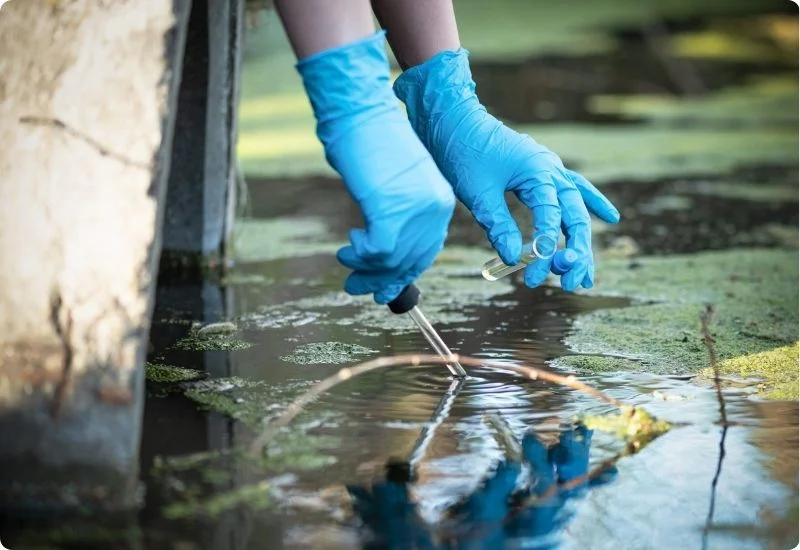
Regular testing is essential for maintaining optimal pond conditions
Frequent Issues and Resolutions Related to Pond Water Quality
Algal Blooms
Algal blooms are often caused by an excess of nutrients, particularly phosphates. Effective nutrient management, along with mechanical or biological control methods, can help prevent and control algae overgrowth.
Low Oxygen Levels
Low oxygen levels are most common during summer. Installing aeration systems and balancing plant populations can help maintain adequate oxygen levels for fish and other pond life.
pH Fluctuations
Regular pH monitoring and maintaining proper alkalinity levels can stabilize pH. If fluctuations are significant, using pH stabilizers may be necessary.
By maintaining proper water quality parameters and regularly monitoring conditions, pond owners can ensure a healthy, balanced ecosystem that supports aquatic life and provides aesthetic value. Regular testing, appropriate maintenance, and prompt attention to problems will help maintain optimal pond conditions throughout the year.
Related Articles
Vinegar and Ammonia: How to Safely Use These Household Cleaners
Vinegar and ammonia are two powerful and popular household cleaners used for a variety of tasks. ...
Understanding The Dangers of Mixing Bleach and Ammonia
When it comes to household cleaning, bleach and ammonia are two powerful agents often used for ...
What Is Limescale and Why Should Care About It
Limescale is a common problem that affects many households, especially in areas with hard water. ...
How to Change Pond Water to Keep Your Pond Pristine
Maintaining a well-balanced ecosystem in your pond is all about keeping water quality in check. One ...
The Importance of Proper Water Changes for Your Aquarium
In this comprehensive guide, we'll explore the importance of water changes , how to determine the ...
What Can Biological Filtration Do for Your Pond?
Biological filtration represents a cornerstone technology in both natural ecosystem management and ...

